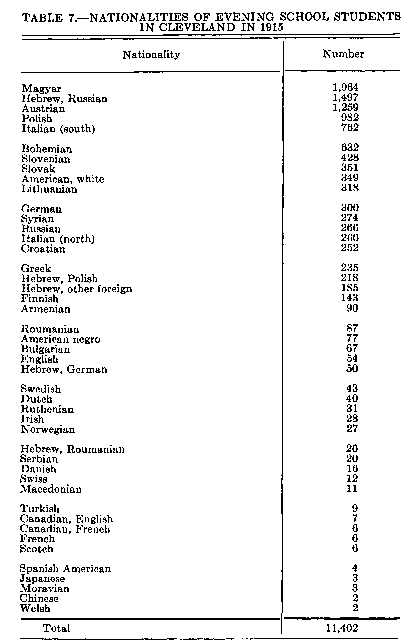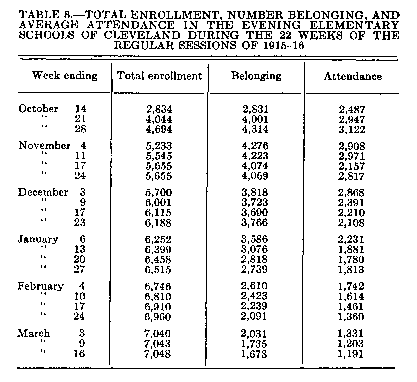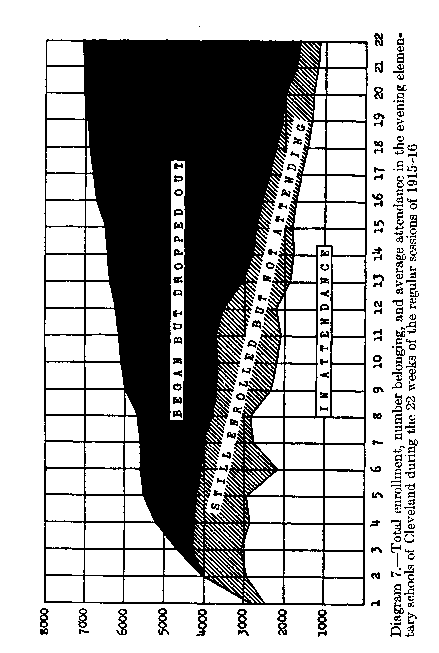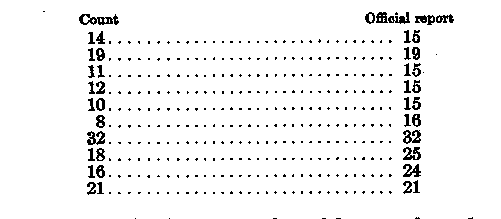The School and the Immigrant
Chapter 6: The Adult Immigrant and the School
Herbert A. Miller
Table of Contents | Previous
The most important instrumentality for the instruction of the adult immigrant is the public night school. Cleveland has maintained night schools for the past 35 years. The first one was probably established in 1880 and had as its object the instruction of boys and young men who had left school early or had not been so fortunate as to receive any regular education whatever. This first school was supported partly by the Newsboys' and Bootblacks' Home and partly by the Board of Education. Its work proved so successful that the Board took over its control and proceeded to establish other similar schools elsewhere in the city. Very soon the character of the work carried on began to change. More and more non-English-speaking men attended until finally the evening schools have become almost exclusively devoted to the instruction of foreigners in the English language.
EVENING SCHOOLS FOR ADULT FOREIGNERS
The evening schools in Cleveland have increased in scope and importance until they have become a large educational enterprise, enrolling in the
(86) school year of 1914-15 more than 11,000 students.
These schools open in October and continue in session for 20 or 22 weeks, being open four nights each week. At the close of the regular term in March most of them suspend work, but a few are continued for a further period of several weeks. The experiment has even been tried of continuing a few of the night schools through the summer months. The classes are held in regular elementary school buildings and about one-fourth of the teachers are also employed as teachers in the day schools while the remaining three-fourths are people working at other occupations during the day.
The following data give the principal facts concerning the Cleveland evening elementary schools for 1914-15.

( 87)
Among the students attending these classes, 20 out of every 27 are foreigners. The cosmopolitan nature of the student body is shown by the figures of 'fable 7, which gives the number of students in each of 45 nationalities enrolled during the school yeas of 1914-15. It will be noted that the total of this table is 11,402, although the official records show a total enrollment of 11,383. The Survey has not been able to find the cause of this slight discrepancy as both sets of figures one from the official records.
CITIZENSHIP CLASSES
In addition to their regular work, the evening schools established, two years
ago, classes in citizenship for the benefit of aliens desiring to secure
naturalization papers. During that winter these classes enrolled more than 1,400
men. Last year the total enrollment was about 1,300. During the winter of
1915-16 the number was less than 000. This does not mean, however, that during
the past winter 600 men have been in regular attendance at these classes.
This number represents the total enrollment for the school year, that is, the
number of different individuals who have joined the classes and been in
attendance for any amount of time, long or short. During the winter of 1915-16
the citizen-
( 88)

(89) -ship classes were in session one night each week and the attendance, which began with 230 in October, rose to nearly 300 two weeks later and then slowly but steadily declined to a little over 100 at the close of March.
The motives which prompted the establishment of the citizenship classes are deserving of the heartiest approbation and support. Socially and educationally this innovation is wisely planned and worthy of continuation and extension. Nevertheless the fact is that these classes are making a most meager contribution toward helping aliens to become American citizens. Their enrollment is progressively decreasing and their attendance is but a small fraction of their enrollment. The official records indicate that the great majority of the men who enter these classes become discouraged and drop out after attending for a few nights. It is undoubtedly true that the great European war has stemmed the tide of immigration and taken from the city many who might otherwise have been in attendance at these classes. Nevertheless this cannot be the true explanation of the shrinking enrollment and small attendance.
During the early months of 1916 there were from 100 to 200 men in attendance in the citizenship classes. At the same time the number of adult foreigners of voting age in Cleveland who
(90) had not even taken out their first papers was probably not less than 50,000. Moreover, the number of unnaturalized aliens in the city has been steadily and rapidly increasing for a number of years and hoe now reached the point where Cleveland's record in this matter is poorer than that of almost any other large city.
Under these circumstances it is a matter calling for serious concern that the citizenship classes should be shrinking in size, that most of their students drop after a few nights of attendance, that the official records of the work fail to indicate how many of the students who take the course succeed in securing their naturalization papers, and that the attendance amounts to less than one-half of one per cent of the men in the city to whom such classes should make their strongest appeal.
In the opinion of the members of the Survey Staff the causes of these unsatisfactory conditions are to be found in the character of the instruction given in these classes. The trouble is that the teaching does not follow any well matured plan and is not skilfully done. It suffers from the same sorts of weaknesses that restrict the value of the instruction given in the regular evening schools. The nature of these shortcomings is considered in detail in the following section.
( 91)
QUALITY OF INSTRUCTION IN EVENING SCHOOLS
It appears that the educational officials of the Cleveland school system are highly satisfied with the quality of the work done in the evening elementary schools. In the printed report for 1914, and again in that foe 1915, the city superintendent and the supervisor of evening schools inform the public that "Our evening schools rank high as to quality .d amount of work done, and are very much superior to nearly all of those in other cities in regularity of attendance and much lower in cost per capita."
It is impossible for the members of the Survey Staff to share the optimism of the superintendent and supervisor in this matter. During the course of the Survey 66 visits have been made by five members of the Survey Staff to evening elementary classes. As a result the conclusion has been forced upon these observers that the work done in these classes is very far from ranking high in either quality or amount. While there are many enthusiastic teachers and hundreds of eagerly conscientious pupils, the classroom work exhibits an almost total lack of unified plan, matured method, and intelligent direction. The trouble is that the teaching methods have not been intelligently adapted to the needs and abilities of the pupils.
Thetypical characteristics of the work are
(92) well illustrated by that observed in five successive classrooms in one school visited in March, 1916. The pupils were almost entirely young foreign men of from 25 to 30 years of age. Many of them were employed in one of Cleveland's great steel manufacturing establishments. They were not illiterate, but they had almost no knowledge of English. They were all weary from their day's work and they kept awake only by the exercise of apparent effort.
In the first of the five classes a writing lesson was being conducted, and these husky laboring men were busily engaged in copying, "I am a yellow bird. I can sing. I can fly. I can sing to you."
In the second class the teacher was barely able to talk English and the work was almost entirely conducted by the translation method. The teacher made several fruitless attempts to get the pupils to speak English. He did this by telling them repeatedly, "Think the sentence in your own language and then try to translate it into English." After this had failed to produce satisfactory results, the teacher gave it up and had them read a selection about making pickles from cucumbers.
The third class was taught by a bright young foreigner who had apparently received a classical education. The work was conducted just
(93) as are many classes in Latin. The teacher spoke English almost perfectly, and although his pupils could neither speak nor understand it, he carefully explained to them about inflections, voices, moods, tenses, numbers, and persons. He then told them they that were to conjugate "to have" and "to be." After this was explained to them in their own language, the pupils all went to the board and began to write "I have, thou hart, he has," and "I am, thou art, he is," etc. The teacher explained that "art" was the second person singular, indicative mood, present tense, of the substantive verb "be." After this the class had a reading lesson from the third reader about a robin that said, "God loves the flowers and birds too much to send the cold to freeze them."
In the fourth room the pupils had a reading lesson about "Little drops of water, Little grains of sand." They then had a spelling lesson of the words in the reading selection. The teacher was interested, vivacious, and expended a great amount of nervous energy in talking very rapidly and almost incessantly. She took up most of the time with her own activity and most of the pupils could not understand what she was talking about.
In the fifth and last class the teacher was also most voluble and talked more than all the stu-
(94) -dents combined. It was a reading lesson and the 14 men present were engaged in reading a selection beginning
"Oh, baby, dear baby,
Whatever you do,
You are king of the home
And we all bond to you."
Similar examples might be multiplied from the written records of the work observed in the evening classes, and classes of the sort described may be seen by any one who will take the time to visit the evening schools of the city. Perhaps the most impressive characteristic of it all is that every teacher appears to be entirely free to teach whatever he pleases by any methods that he wishes to use. The lessons assigned and the methods employed in the different rooms are astonishingly varied. There seems to be no effective supervision, no plan for improving the teachers in service, and no effort to find out which of the many methods used produces the best results.
REORGANIZATION ESSENTIAL
In the opinion of the Survey Staff it is essential that the evening elementary school work of Cleveland be reorganized. Some of the results of the work as at present conducted are revealed by the attendance records. The data for the 22
(95) weeks of the regular term of 1915-16 are shown in Table 8 and Diagram 7. They refer to the evening elementary schools and the citizenship classes. They show that when the classes opened in October, some 2,800 students enrolled and almost all were actually in attendance. A month later the enrollment had increased by 2,500, but the attendance was only 500 greater than at the beginning. This means that even in the first few lessons large numbers of the students had become discouraged and dropped out.
From this point on the enrollment steadily increased, showing that new pupils were continually joining the classes, but the number belonging and the number in actual attendance steadily decreased, indicating that other pupils were dropping out. By the end of the regular term in March, the enrollment was more than 7,000, while the attendance was only a little over 1,000.
Moreover, there is evidence pointing to the probability that the loose methods of record keeping used in this part of the school work result in reporting conditions somewhat more favorably than the facts warrant. Under the present regulations a class is suspended when the attendance falls below 17. Upon the occasions of visits to the classes the pupils present were counted by the Survey visitors and in a
(96)

(97) large number of cases fewer than 15 were found present on the night of the visit, although the number reported at the central office as the average for that week was always 15 or over.

These discrepancies would be possible on the supposition that the visitor almost always happened to call on a night when the attendance was lower than it was for the there other evenings of that week. However, it seems more probable that the record keeping is not entirely accurate. The following comparison shows for
(98) the first 10 classes in the list compiled by the Survey the number counted on the evening of the visit and the number reported for that class on the official record as being the average attendance for that week.
Whatever the facts may be with regard to the accuracy of the reports, the important features of the situation are that the attendance in the night classes is very much less than the enrollment and that great numbers of immigrants enter the classes, become discouraged, and drop out after a brief attendance. Cleveland has been repeatedly told that there were more than 10,000 students enrolled in the night schools. Probably few citizens have realized that this number represented, not students in school, but rather names in books. They have not realized that a count of all the students actually present on any pleasant evening during the middle of the term would have shown only about one-third of that number and that a count near the
(99) close of the term would have shown one-fifth or less. The tragic part of the situation is that every year thousands of earnest and hopeful foreigners flock to the night schools in keen anticipation of learning English, and after a few weeks become discouraged and drop out because the teachers do not meet their needs. Since they cannot understand what is going on, their interest flags. As the weeks pass by, physical weariness overcomes them more and more each night. Finally they sink into despondency and discouragement as they see their cherished dream of mastering the new language depart. This is no matter of casual import for these men and women. 'They are not children and most of them are not students. Concentrating their minds on the lesson implies painful effort. If this intense application does not bring them within a few weeks some results that the immigrant can appreciate he begins to realize that his constructive ideal, his dream of becoming an American, his opportunity for success in the new land, are not to be attained through the public school.
These men and women of the evening schools have no abstract zeal for knowledge. They are interested in the immediate, the concrete, and the practical. They resemble children in that
(100) they are ignorant and need help, but they are mature in ideas and realizations and keenly conscious of specific needs. This is why they cannot be interested in inflections and tenses and why they are not gripped or thrilled by reading about the beautiful posies and the pretty birdies. They want to learn to talk English, and they can be kept interested only so long as they can use each day what they learned the night before.
There are 70,000 people in Cleveland who cannot speak English, and there are few social, civic, or educational problems more important than to make it possible for this tenth of the city's population to understand and communicate with the other nine-tenths. The number of unnaturalized adult foreign men is nearly as large as that of the non-English-speaking inhabitants. Moreover these conditions are becoming worse rapidly and steadily. Again Cleveland makes a poorer showing in these respects than any other large city.
For these reasons the Survey deems it essential that the elementary evening schools of this city should be reorganized so as to do efficient work in teaching English to foreigners. What is most needed is leadership. One thoroughly competent supervisor, charged with responsibility for making the work efficient, and given
(101) greatly increased power in tire selection, training, and direction of his assistants, could work rapid reform in the whole situation. While increased appropriations are needed for supplies and for teachers, they are not nearly so important as skilled and enterprising leadership. Cleveland should profit by the example of other cities. The school authorities here should know what Detroit has accomplished within the past year in dealing with this same problem. Board members and educational officials should carefully read the report entitled, "The School and the Immigrant," recently published by the New York Department of Education. A careful examination should be made of the 20 different books and sets of books telling how to teach English most successfully to foreigners. The city cannot afford to be indifferent, or inefficient, or contented in its attitude toward helping its aliens to help themselves.
SUMMARY
The evening elementary schools of Cleveland have been in existence for 35 years. At the present time their total enrollment each year is in the neighborhood of 10,000. The classes are open during about 20 weeks, four nights a week. Almost all the students are foreigners
(102) and their main object is to learn English. In addition to their regular work the evening schools have established classes in citizenship.
In the opinion of the Survey Staff, based on visits to a considerable proportion of the classes, the work in the evening elementary schools falls far short of being well and efficiently conducted. The records of attendance show that only a small proportion of those who enroll remain more than a few weeks. Many thousands begin, become discouraged, and drop out. It is the conviction of the members of the Survey Staff that a reorganization of this evening elementary school work is essential. The most important factor in reorganization is efficient leadership.